
Scenes from the winery
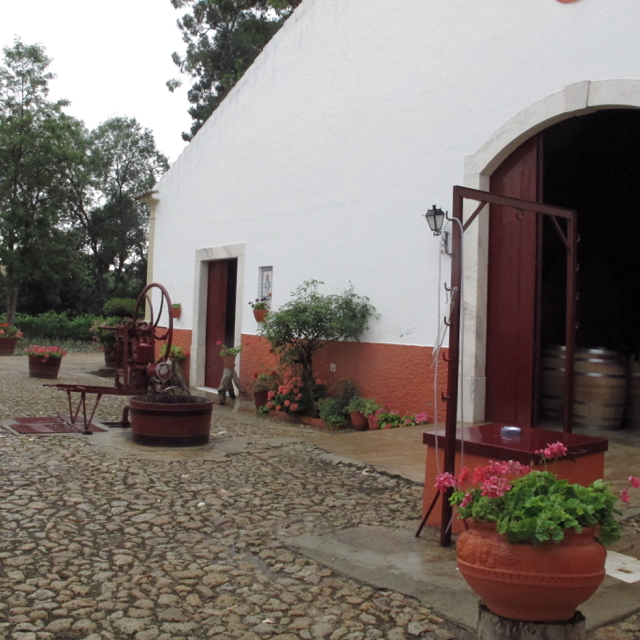
Last Thursday we headed out from Lisbon to the Alentejo for a day visit to the fabled Mouchão estate. Normally the Alentejo in summer is hot and dry. Instead on Thursday we were met with heavy rain lit up by impressive flashes of lightning. We were shown round by David Marques Ferreira, who has been estate manager for the past three years. CRM and I had met David at last December’s Adegga Wine Market in Lisbon.
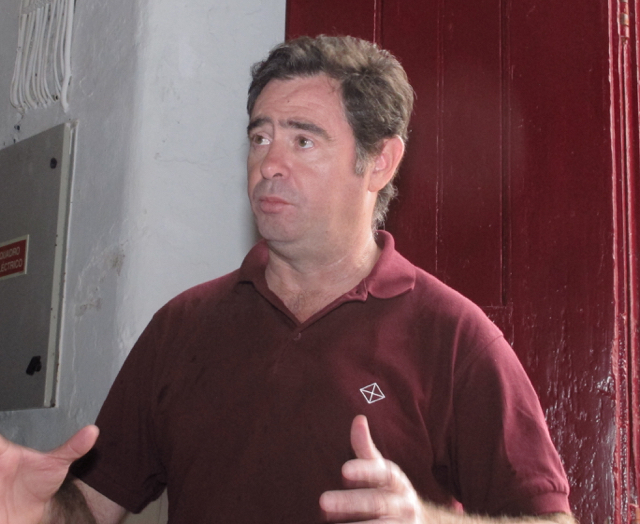 David Marques Ferreira
David Marques Ferreira
Established in the 19th century Mouchão is the oldest estate in the Alentejo – the other side of the River Tejo. The 1000 hectare estate is owned by the Reynolds family, who in the 19th century, were the leading producers of cork. At the end of the 19th century they decided to diversify into wine and in 1890 planted their vines – they have 38 hectares with no intention to increase the area under vine. They chose to major on Alicante Bouschet, a teinturier variety, which remains Mouchão’s signature grape variety. David Ferreira –Alicante Bouschet is « our body and soul ». The winery was built in 1901.
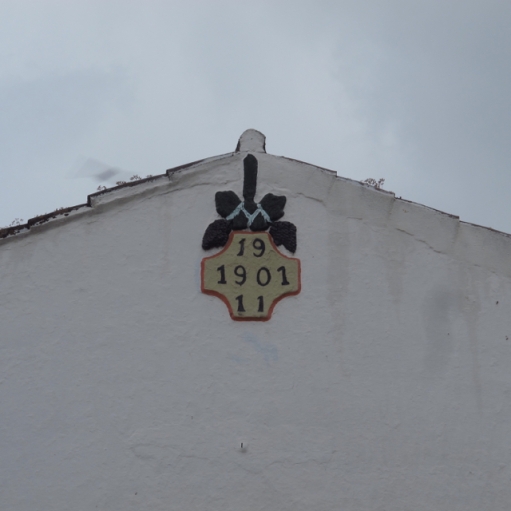
« Alicante Bouschet gives us more than just colour, » David Ferreira explained. « We get big tannins and freshness. Our vines are at 200 metres altitude, which is high for the Alentejo. Some of our vines are at 300 to 400 metres, so we get freshness and acidity. This helps our wines to age well – the 1954 is still good ».
« Although we have a variable geology, sand and clay is the basis, so we retain moisture during the hot summers, » Ferreira continued. « The estate is between two rivers – hence the name Mouchão. We are very much in the middle of nowhere ».
« We work very traditionally here – limiting production, hand picking, no destemming, wholebunch fermentation, foot treading in lagars and a manual press etc.We mainly use old vats of 5000 litres and prefer French oak with malo in barrel but also use some Brazilian wood. «
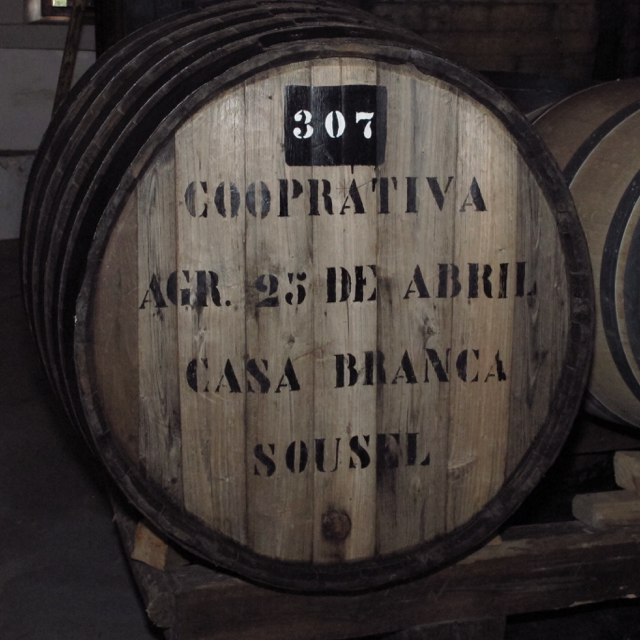
A barrel from the time when the estate was confiscated
and run by the local cooperative
The estate remains in the Reynolds family, which is now into the seventh generation. However, there was a ten-year interruption of ownership following the 1974 Revolution. The estate was confiscated and the wines were made by the local cooperative and sold under the co-op’s name. It was returned to family ownership in 1985.
« The vineyards were in a poor state, » explained Ferreira. « Nothing had been planted and existing vines had not been maintained. We nearly lost our Alicante Bouschet! »
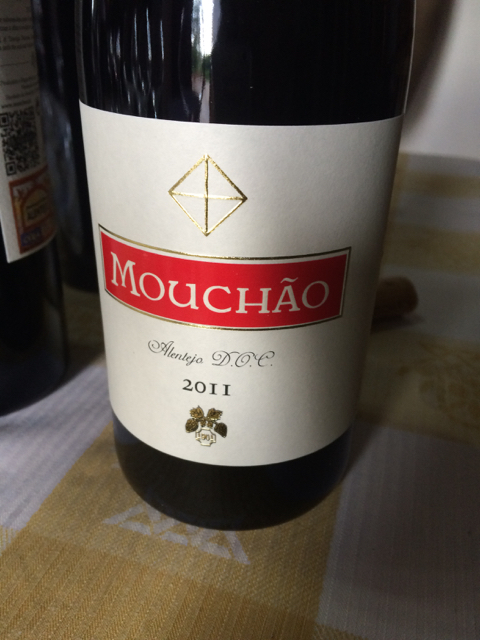
We tasted five wines:
2015 Dom Rafael Branco – blend of Antão Vaz and Arinto 7.69€
Still very youthful and tight in the finish but with attractive pineapple and grapefruit notes. Good value.
2013 Dom Rafael Tinto – blend of Alicante Bouschet, Trincadeira and Aragonez 8.99€
This spends one year in a mix of large vats and small barrels and then a further year in bottle. As Mouchão’s entry level red, I think this elegant wine is stunning value! It has lovely velvety texture, herbal and spicy notes, structure and acidity. Really a steal at 8.99€ and will clearly age well over the next few years.
2012 Ponte de Canas – Alicante Bouschet (40%), Touriga Nacional,Touriga Franca, Syrah 16€
Unlike the other Mouchão wines this has a small percentage of Syrah that gives this wine additional freshness and edge. The 2012 already has attractive texture and powerful fruit but ideally it needs several more years in bottle to show its best.
Over lunch we had an interesting discussion with David over Ponte de Canas as he indicated that the current name used on the label may not make it sufficiently clear that Ponte de Canas was actually a wine from Mouchã0.
We suggested that Mouchão ought to be part of the Ponte Canas name and suggested Ponte Canas de Mouchão or Ponte de Mouchão citing that. for instance, Château Latour uses Les Forts de Latour. Clearly the name is under discussion, so we may see a change in the future.
2011 Mouchã0 – 85% Alicante Bouschet, 15% Trincadeira 35€
We were privileged to be the first to taste the 2011 grand vin, which will be released soon. Naturally this deep coloured wine is still very young and tight in the finish but it has a lovely warm spicy aromas and an opulent texture.
2011 Vinho Licoroso – 100% Alicante Bouschet 19€
This is Mouchão’s version of Port – made in the same way using grape spirit distilled at the winery to stop the fermentation and fortify the wine. Very concentrated with long rich cherry and prune fruit.
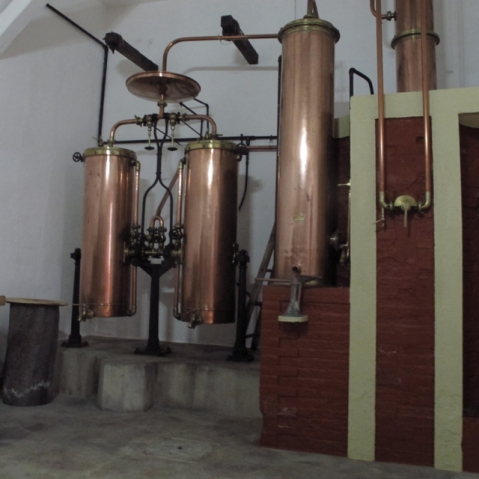
The still
•••

A Taberna do Paulo
Rua 1 de Maio, 28 | Santo Antonio de Alcorrego
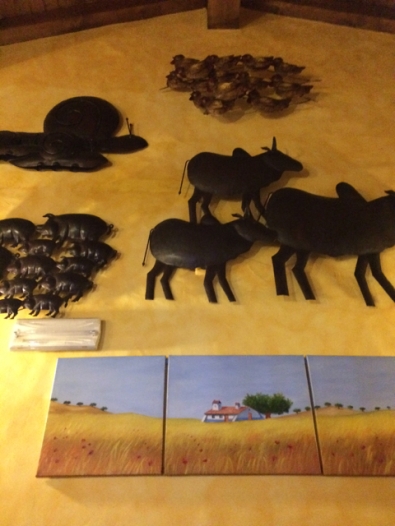
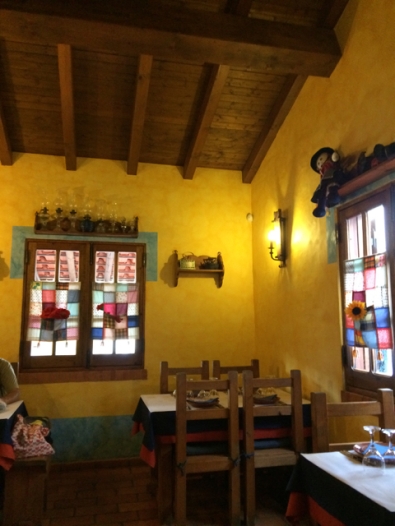
After the tasting we all drove to nearby Santo Antonio de Alcorrego to the brightly decorated A Taberna do Paulo where we had a very enjoyable lunch featuring three different types of migas – plain, with tomato, and with coriander – accompanied by small lamb chops.
Our visit to Mouchão reminded me of Tondonia in Haro (Rioja). It has the same sense of calm and great respect for tradition.
Ferreira summed up – « We say Mouchão is Mouchão! »
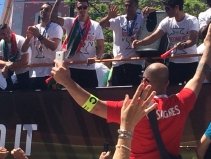
Jim Budd

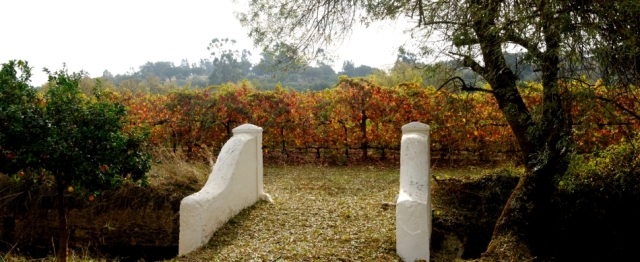
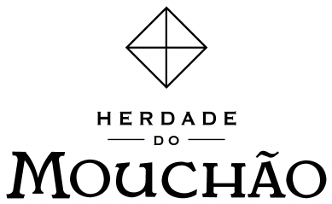

Have you ever tasted the Pêra Manca white by Cartuxa?
J’aimeJ’aime
I was granted the opportunity to visit the « Foundation », Hervé, on behalf of In Vino Veritas at a time when you still were working for the « concurrence », and benefitted from a very strong recommendation issued by the Portuguese embassy in Brussels. But it lies a good 50 km to the south of Mouchao (near Casa Branca this one), close to the smashing town of Evora: white walls and pretty girls (university) all over the place. I was a bachelor at that time (!) and had been driven to the place by someone from ICEP. The casks are housed in the ancient … library of a convent that had been confiscasted when Pombal dismissed the Jesuits and other clerics !!!! NB: Ch. d’Epiré in Savennières also houses its barrels in an old church that was desacralized during the Révolution.
I had tasted Pêra Manca before, privately, but just once as far as the white is concerned (in a pousada). There, we were offered several swallows. This happened somewhere in the late nineties and so there were not yet many vintages available, and they would have been “young”. The red is everything you expect from very ripe tempranillo (= aragonez), and the delicate tinta amarella (= trincadeira), exhibiting soft tannins and that “plum” character we are used to. The white (still with the old colourful label of course) was very much in the oxydized style, as often is the case with ripe antao vaz, but not in an unpleasant way (honey). Yet the arinto keeps it fresh (see Bucelas). Unfortunately, I know nothing of the younger version. Prices are quite high.
Last thing about Evora: good restaurants, and they serve you the Alentejan broth, a light poultry consommé with lots of garlick, thin slices of tomatoe and chorizo and a wealth of broa de milho, that soft corn-bread which is typical of the region. Slurp!
J’aimeJ’aime
Hervé. Yes we drank the Pêra Manca white in a Lisbon restaurant a few years back. It was rather good!
J’aimeJ’aime
Good. I have a very vivid memory of a short visit there in the 90’s and I was really impressed by the white, especially as I thought it was a red region. Happy to hear that though the times they are a changing, some good wines remain.
PS. I never really worked for the concurrence, Luc; at the time, my main source of income came from a retail magazine, but I was already writing articles for IVV, though in small quantities. When we celebrated our 20th anniversary, looking at old copies, I realised I was the oldest contributor still working for the magazine, with our good friend from Québec Daniel – and Ze Big Chief, of course!
Talking about the 90’s, I remember a presentation you gave in Brussels about Portuguese wines, when I said to myself, wow, « this guy is really smart! ».
Haven’t changed my opinion, by the way. The so-called little grey cells seem to age rather well.
J’aimeJ’aime
This « concurrence » business was a joke. I know of at least 4 people who contributed papers to the RBVS-team and to Philippe’s as well: G. Jansegers, H. Deschepper, P. Fiévez and this little chappy who was working for a company involved in editing credit cards and was a good friend of M. Michiels and M. Kreydenweiss as well. You see the grey cells are at fault: I cannot remember his name (Het schiet me maar niet te binnen!).
But back to Pêra Manca: as you know, the reds are something « recent » (after a long hiatus), dating back to 1991. I would love to taste an « older » one in this series to see how it fares after 25 years.
By the way, when one calls Alentejo a « Red Region », one alludes to its political status at the time of the Revoluçao dos Cravos. But you are right, if I believe this: http://www.vinhosdoalentejo.pt/media/documents/20151102_4182d3.pdf , the proportion of wines is as follows: red = 78,9§, white = 19,7 % and only 1,4 % rosé (as of 2014).
J’aimeJ’aime
Marc, ça te dit quelque chose, un banquier qui faisait des piges chez IVV au début du magazine, et qui connaissait Hamilcar Michiels?
J’aimeJ’aime
Je me confonds en excuses auprès de ce quidam, très aimable garçon et grand connaisseur en vins d’Alsace … Giers ou qqchose comme cela, non? Sic transit memoria populi !
J’aimeJ’aime
Oui, Jacques Giers? Il ne travaille plus pour nous depuis un certain temps déjà. Il a fondé un site avec Patrick Fiévez,
c’est ici: http://www.leguidedachatdesvins.eu/ (publicité gratuite)
J’aimeJ’aime
Merci pour cette piste.
Pera Manca 2008 est un très bon vin qui m’a rappelé un Hermitage.
Jolis blancs goûtés récemment :
Vignoble de Bairrada – Quinta Das Bágeiras (Mario Sergio Alves Nuno ) : DOC Bairrada « Pai Abel » 2014 (cépage cical)
Vignoble de Bairrada – Filipa Pato : DOC Bairrada « Nossa Calcario » 2014 (cépage bical)
Vignoble de Barriada – Bussaco (Alexandre d’Almeida) : Vinho de Mesa « Buçaco Branco Reservado » 2001 (bical, arinto)
Des rouges haut de gamme :
Vignoble de Bairrada – Caves São João : DOC Bairrada « Reserva Particular » 1978 (baga)
Vignoble de Bairrada – Quinta Do Ribeirinho (Luis Pato) : Vinho Regional de Beiras « Primeira Escolha » 2001 (baga)
Vignoble de Bairrada – Quinta de Foz de Arouce : Vinho Regional Beira Atlantico « Vinhas Velhas de Santa Maria » 2011 (baga)
Vignoble d’Alentejo – Quinta da Plansel : Vinho Regional Alentejano « Dorina Lindemann – Limited Edition » 2013 (touriga nacional, touriga franca)
Grand vin :
Vignoble du Douro – Casa Ferreirinha (Sogrape Vinhos) : DOC Douro « Quinta da Leda » 1995 (touriga nacional – même maison que le célèbre Barca Velha)
J’aimeJ’aime
Très jolie brochette, que je t’envie depuis mon exil forcé en terre roussillonnaise. J’ai découvert Bageiras alors qu’ils étaient encore en travaux. Ils possèdent des vignobles très crayeux près de Sangalhos, où on voit encore les anciens petits fours à chaux: très pittoresque. Je parle d’il y a plus de 20 ans. Les bagas étaient très ronds et souples, ce qui est rare.
Filpa Pato est l’une des 3 filles du fantastique Luis Pato, le DIEU de la viticulture portugaise, Adorable type, chimiste de formation, c’est un plaisir de le côtoyer: intelligence, courtoisie, raffinement. Sa fille élabore des vins très personnels, après avoir notamment fait un séjour en Argentine. Elle a épousé Wiliam Wouters, restaurateur anversois et ancien meilleur sommelier de Belgique. Il a appris le portugais en une-deux-trois et elle parle le flamand avec un accent délicieux! Ses vins sont très fins.
Attention, Bussaco n’est pas en appellation Bairrada (où alors je me trompe), car ils mélangent des raisins de la Bairrada et d’autres venant d’autres district des Beiras (ou même du Dao, je ne me souviens plus). Par contre, l’hôtel lui-même, dans un splendide parc forestier, se situe bien dans l’arrière-pays de Coimbra. A visiter absolument et pas trop cher (restaurant bof-bof, jadis).
Les Caves Sao Joao gardaient des « très vieux » vins à tous les sens du termes, fort oxydatifs. Je ne sais pas actuellement.
Quant à Ribeirinho, c’est là que Luis a planté ses Baga en pied franc (début du millénaire), car la zone est très sablonneuse, et j’ai rarement bu des vins aussi éclatants, malgré leur jeunesse. Phénoménal (pé franco).
Avant, Ferreirinha (et bien sûr Barca Velha) appartenaient à la même maison que les portos Ferreira, bien sûr. Ils étaient quasiment les seuls « shippers » à détenir des vignes en propre. Cela a bien changé. Et Sogrape a racheté le tout.
J’aimeJ’aime
Merci pour ces rebonds, Luc
Je me renseigne pour Bussaco, sachant qu’un des jolis vins rouges de la série était aussi :
Vignoble de Bairrada – Bussaco (Alexandre d’Almeida) : Vinho de Mesa « Buçaco Reservado » 2005
L’info nous a été fournie par Nelson Guerreiro, restaurateur à Lisbonne (et qui a choisi ces superbes vins).
J’aimeJ’aime
Vinho de Mesa veut bien dire « Vin de Table ». Comme exposé, mon souvenir (60 ans) n’est plus très précis quant aux conditions qui empêchent de revendiquer l’AOP. Si tant est qu’on le souhaitât!. Au domaine, nous avons « tout » en Vin de France depuis 2015.
J’aimeJ’aime
Le compte-rendu complet est ici :
http://www.invinoveritastoulouse.fr/index.php/degustations-thematiques/toutes-les-degustations-thematiques/752-quelques-vins-du-portugal-une-decouverte-fantastique
J’aimeJ’aime
Ping : 2016 Adegga Christmas Wine Market – Premium Room report | Les 5 du Vin